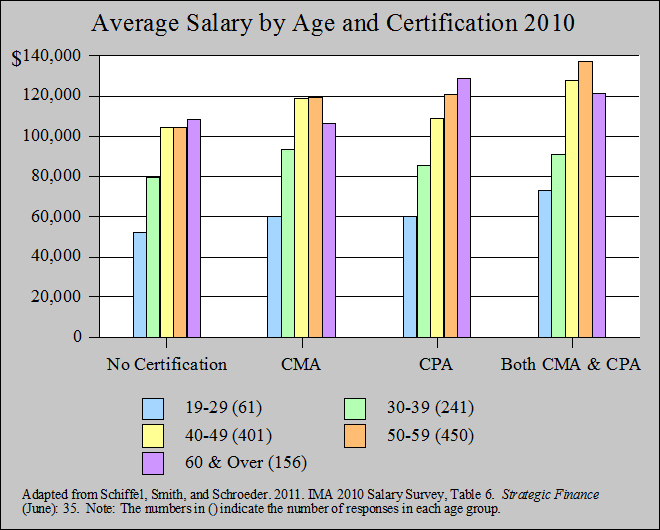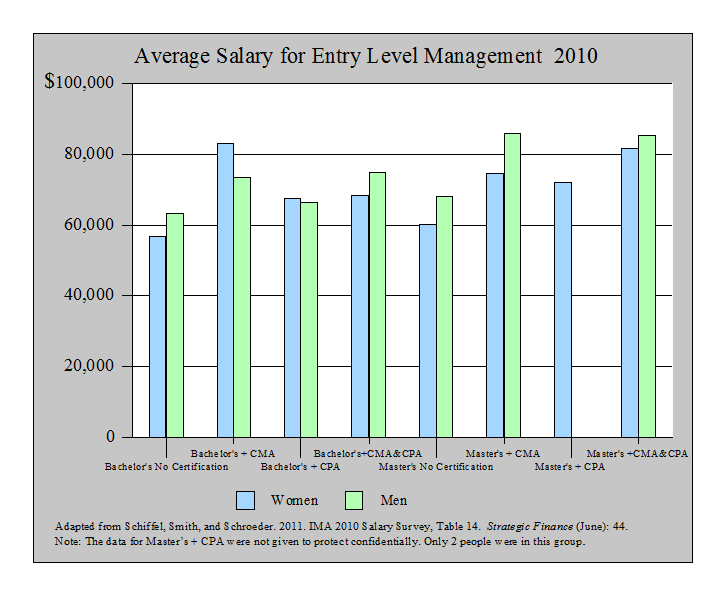
Note by James R. Martin, Ph.D., CMA
Professor Emeritus, University of South Florida
How to Manage Yourself Main
| Professional Certification Main
The purpose of this article is to provide a variety of salary data and to show how the recovery from the recent recession affected IMA members. The article is fairly long and includes a considerable amount of detail related to salary and total compensation for a sample of IMA members.1 Salary data is provided in 14 tables and 7 figures. The various illustrations are based on age, gender, years in the field, level of management, supervisory responsibility, certification, highest degree, organization size, SIC area, business structure, marriage status, state of employment, and position. The authors also provide a method of estimating a salary level based on highest degree, certification, top level or entry level, and years in the field. My main purpose in developing this note is to provide some information related to the value of a master's degree and the CMA and CPA certifications. This note provides more specificity to my previous summaries of the papers, "The master's as the new bachelor's" and "Is grad school worth the investment?"2
Compensation and Certification
The illustration below was adapted from Schffel, Smith, and Schroeder's Table 6 to show the average salary by age and certification. In all age groups, those with a CMA or CPA earned more than those without a certification. Except for the 60 and over age group, those with both CMA and CPA earned more than those with just one certification. This data indicates that the monetary benefits of certification tend to continue throughout one's career.

Compensation and Combinations of Bachelor's, Master's and Certification
The authors provide data on average salaries for four groups in their Table 14. These include top management, senior management, middle management and entry-level management. I developed the graphic below for the entry level management group to help students see the benefits of obtaining a master's and certification.
With one exception, the data in the illustration below shows that those with a CMA or CPA and a master's degree have higher average salaries than those with just a bachelor's degree and no certification. The exception is that women with a bachelor's and CMA (17 women) had a higher average salary than women with a master's and CMA (16 women). No explanation is given for this in the article, but since the number of people is fairly small, a couple of high or low salaries could have caused the exception.

Estimating A Salary Level
The salary estimating method provided below shows the average value of being either at the top or entry level, having some other level of experience, holding an advanced degree, and a CMA and/or CPA certification. A person at the entry level with a bachelor's degree in accounting, with no experience, no advanced degree, and no certification can expect a starting salary of $75,469 - 27,777 = $47,692. On the other hand, an entry level person with a master's degree in accounting and a CMA can expect a starting salary of $75,469 - 27,777 + 11,028 + 12,971 = $71,691. This estimate based on the 2011 salary survey is $74,811. For updates see note. 3
| Salary Estimate Based on the 2010 Salary Survey | ||
| Calculation | Potential Amounts |
Your Calculation |
| Base amount | $75,469 | $75,469 |
| For top level management, add | +36,320 | |
| For entry level management, subtract | -27,777 | |
| Add number of years in field multiplied by 717 | (N)(717) | |
| For an advanced degree, add | +11,028 | |
| For a CMA, add | +12,971 | |
| For a CPA, add | +7,239 | |
| Estimated salary | ||
Using a line from Simon's paper (see note 2 below), a master's of accountancy and a professional certification are both in the "you're crazy if you don't get them" category.
____________________________________________
1 The data is based on 1,505 usable questionnaires returned from a sample of 5,201 IMA members.
2 See Pappano, L. 2011. The master's as the new bachelor's: Call it credentials inflation. A four-year degree may not cut it anymore. The New York Times Education Life (July 24): 16-18. (Summary); and Simon, C. C. 2011. R.O.I. Is graduate school worth the investment? The New York Times Education Life (July 24): 18-19. (Summary).
3 See Martin, J. R. 2021. IMA Salary Calculators 2010-2020. Management And Accounting Web. Salary Surveys
Related summaries:
Krippel, G. L. and S. Mitchell. 2011. What's your CMA worth? We show you how to estimate the lifetime value of the certification. Strategic Finance (November): 41-47. (Note).
Krippel, G. L. and S. Mitchell. 2017. The CMA advantage: An update. How much more could you earn throughout your career if you became a CMA right now? Strategic Finance (September): 38-45. (Summary).
Brausch, J. M. and D. Whitney. 2009. CMA: The quest for increasing value. Strategic Finance (December): 9-10, 12. (Beginning in the spring of 2010 the CMA exam will include only two four-hour exams, each consisting of 100 multiple choice questions and two 30-minute essay questions). (Summary).
Pappano, L. 2011. The master's as the new bachelor's: Call it credentials inflation. A four-year degree may not cut it anymore. The New York Times Education Life (July 24): 16-18. (Summary).
Simon, C. C. 2011. R.O.I.: Is graduate school worth the investment? The New York Times Education Life (July 24): 18-19. (Summary).
VanZante, N. R. 2010. IMA's professional certification program has changed. Management Accounting Quarterly (Summer): 48-51. (Summary).